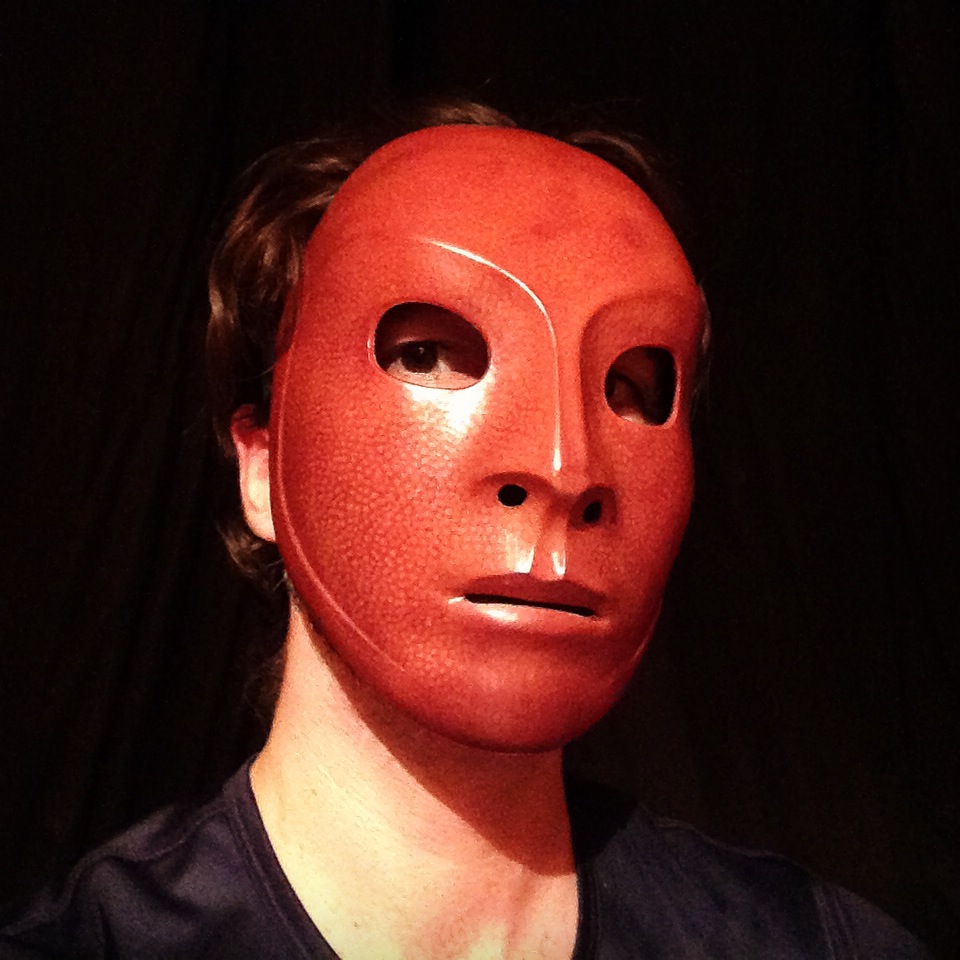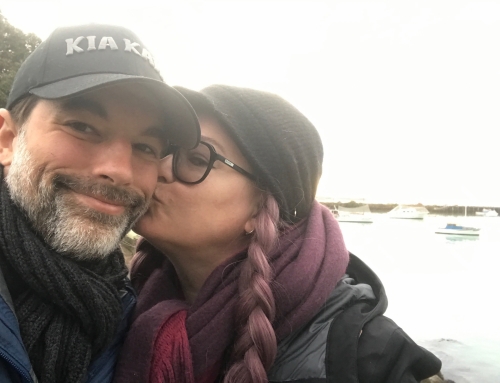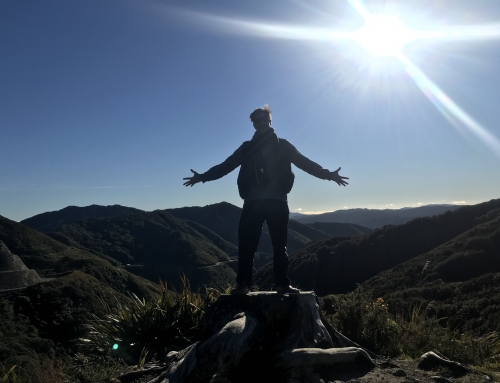Who are we before we become the character? That is the question that the Neutral Mask seeks to answer.
“There are three masks:
the one we think we are,
the one we really are,
and the one we have in common.”
– Jacques Lecoq
It has been years since I have studied the deep and subtle foundations of the theatrical art, and returning to its arcane depths has given me a creative revitalization that I desperately needed.
Last week I went to a Neutral Mask workshop, taught by Sarah Liane Foster of the Nomadic Theater Company. She has recently returned from teaching for four years at Helikos, a physical theater school in Italy. Watching her blog every week about the experience gave me a vicarious reminder of being in Dell’Arte, the physical theater school in Northern California that she and I both attended.
During the Dell’Arte experience – that’s what it’s like to go through an intensive year of physical and theatrical training, with an ensemble secluded in the mountains, it’s an experience of a lifetime – I took copious notes. I filled my notebooks full of teachings and insights and exercises, so I could refer to them in the future if I ever had the privilege of teaching theater someday. Had I the skills for it back then, I would have done what Sarah did, and blogged about it.
Sarah’s blog Avventure was a weekly exploration of the intensive ensemble experience. She would share the biggest insights and breakthroughs of the week, both from her students and herself. It was wonderful to watch her blog from afar, and vicariously experience the sweaty black-clad ensemble in their investigations into performance.
Sarah also works with my absolute favorite charity in the world, Clowns Without Borders. Charities come in all shapes and sizes, and each has different purposes and goals. This one, I feel, does some of the noblest work in the world.
Clowns Without Borders goes into refugee camps, disaster areas, and war zones to find children and make them laugh. Their performances bring a momentary respite of laughter into a place where laughter doesn’t come easily, if at all. They bring light into the darkest of places.
This is the bravest and most emotionally impactful work I have ever found; to find someone distraught by loss and despair, and help them forget their troubles for a moment and to laugh, by bringing magical fools from across the world to perform for them.
Fools need to train in their craft, and Sarah is a magnificent teacher.
How neutral can you be?
After the opening ensemble-building warm-ups, Sarah introduced us to the masks. These are Sartori masks, made of leather by the Italian workshop of Donato Sartori. He was approached by Jaques Lecoq with a radical proposal: create a mask that is not any character at all, but has no character itself.
This seemed like a silly idea to Sartori, who was in the habit of crafting Arlecchino masks that were full of character and distinctive qualities. So Lecoq started making one of his own, poorly, and finally Sartori said, ‘stop that, let me do it’ and made the first neutral masks.
The neutral mask is not used for performance. It is a pedagogic tool.
“The neutral mask is a way of understanding performance, not a way of performing.” – Jacques Lecoq
The neutral mask, when placed on the face of a performer, is not entirely neutral. It is a mask sitting on the face of a person, a character, who has idiosyncrasies and characteristics that make them a unique individual.
We started by identifying what these peculiarities were, so we could begin to peel them away.
“The neutral mask can lead an actor to reject his habitual identification in favor of a deeper, simpler understanding of his powers of expression.” – Philip Zarrilli
One performer would stand in the neutral mask and look at the audience. We would sit, and watch, and say words or phrases that came to mind. It might be an emotional state we saw the mask having, or a sentence that conveyed the scene we saw it participating in. “I’m going to do this myself,” “Small person in a big room,” and “Determined” were examples of what people said.
I found this very illuminating to discover the character of the performer. We were analyzing the characteristics they innately possessed, characteristics that they could not hide. These were the essential building blocks of the character of each performer, apparent even while they were in a neutral state.
After some time for feedback, Sarah would direct the performer to make microscopic changes in the body and stance to eliminate the presence of these characteristics. A millimeter forward in the neck, a millimeter back from the sternum, and suddenly, the performer would disappear. Once these defining characteristics were gone, all that was left was the Neutral Mask.
This showed me the first step in achieving an authentic character: the performer must identify their own personality in order to completely remove it from the performance.
Breathe All The Time
It sounds simple, and automatic, and this is the deceptive nature of breath. Because we can’t stop doing it, we can forget to maintain it when we are being intentional.
There is a loss of breathing when we are actively doing something, and focusing on it intently. This can make us tense up our bodies, and this scrambles the communication we are trying to convey through the instrument of our bodies.
The neutral mask moves slowly. The tendency this creates is to pause everything (including the breath) and slowly, intentionally make a movement into the next position, but this can freeze the entire system and make all movement look mechanical.
When Sarah directed us to breathe into the motions, and to make an intentional movement by breathing into it, I could feel the mask come alive. When I took a step forward and looked up, breathing into the expansion of where I was moving to, the mask felt different on my face. It wasn’t a piece of molded leather held on by a strap; it was an intelligent being, riding on the wave of my breath into existence, and it glimmered there for a moment.
 Watching this as an audience member, while my fellow workshop participants were conducting their exercises, was just as enlightening. Being an audience member is even more important when doing mask work, because it is a time when you can purely observe the mask, and see how it creates emotions and reactions in the members of the audience. There were times when someone would turn their head slightly and dart their eyes to the side, and suddenly the mask was a face. It was a living face, because it breathed.
Watching this as an audience member, while my fellow workshop participants were conducting their exercises, was just as enlightening. Being an audience member is even more important when doing mask work, because it is a time when you can purely observe the mask, and see how it creates emotions and reactions in the members of the audience. There were times when someone would turn their head slightly and dart their eyes to the side, and suddenly the mask was a face. It was a living face, because it breathed.
These moments are so elusive and subtle, they are difficult to capture and replicate. This is what makes mask work so fascinating to me; you have to coax the life of the mask out into being, and it can disappear in a moment. Sustaining its presence takes finesse, patience, and breath.
So we have to continually remind ourselves onstage, when we are ignoring the existence of the audience and the reality around us, to breathe, all the time. Breathing is what makes the mask come alive.
Actors are Masters of Visualization
Another epiphany I had during the workshop is that actors, like sports athletes and artists, actively engage in the process of visualization.
We were walking in random paths throughout the space (a very common starting point for physical theater exercises is, “Let’s take a walk,” and you avoid collision with minimal conscious attention) and Sarah acknowledged all the many cluttered details in the space around us – the stacked chairs, the flags hanging from the ceiling, the random memorabilia on the walls, the gymnastics mat folded under the church pews, the refrigerator behind the oaken bar – and asked us to pretend we were in a completely neutral space.
No nothing. No stuff, no details, no eccentricities around us. Just neutral.
This is a skill that an actor must master, because no matter what the audience is doing, where your stage is set, or what is happening in the environment, the actor must believe that he is in the environment of the character, or the audience will never believe it.
We must visualize our entire environment to be something different than what it actually is, and this skill of visualization is what makes actors such great dreamers and doers.
Sports athletes have a great capacity for visualization, as well, but only in a very limited setting. Within the confines of their game, they visualize making their goal, or scoring their point, or seeing their ball make it through a hoop, and then they follow through with actions that fulfill that visualization.
An athlete may return to their isolated, short visualization of scoring a point repeatedly, but it takes only a moment at a time.
The actor’s visualization is an endurance of the imagination, and it must be sustained over the length of their performance.
Neutral Mask Exercises
Snap Catch
We warmed up as an ensemble, six in all, by walking through the space. Someone would snap, and ‘throw’ the snap to someone else, who would snap to catch it. We wandered chaotically throughout the space, keeping a constant eye on everyone else, and on the position of the imaginary ball.
Snap Catch is a great opening exercise, because it fosters a sense of teamwork, connection, and immediate enthusiasm.
Follow the Leader Walk
We played follow the leader, and one person would walk as normally as they possibly could, in their own walk. Everyone else would follow, and try their best to mimic the walk. All the stances and habitual movements were taken on by the rest of the ensemble, and then the leader would step out and watch the group imitating them.
This was an incredibly rewarding experience for everyone. We were able to see a group of performers holding up a mirror to our own gait, and physically identify the peculiarities that made us, us.
As an exercise in introspection, this was huge. We were all gifted with an examination of our personalities from kind and gentle observers. We had to identify and understand our own personality completely in order to be able to come fully into the neutral mask.
All of us were pleased by the feedback, which was very rewarding and validating. My walk was judged to be strong and purposeful, with a theatricality to it, and this is how I would like my own character to be judged. I was told by one fellow actor that because I have complete command of my body, every movement, no matter how slight, was interpreted as being intentional. Although I have many unconscious movements I do not recognize, it was very useful feedback to realize that others think I am being intentional even with my minor, unrecognized actions.
Waking On A Plain
The neutral mask wakes up on a plain for the first time. From a prone position, it wakes, and stands, and looks to the horizon.
This is the exercise where I failed fast. I have a close relationship with failure, because I do not fear it. When I fail big and quickly, I can learn things very rapidly.
“It is not about succeeding at something, but seeing what happens when you try it.”- Sarah Liane Foster
I woke up on the plain, looked around quickly, and got dejected. I played a character that realized he was lost on a plain, and maybe he had seen it before. He had an opinion about the experience, and this is where I failed.
When I finished my performance, everyone sat looking at me with that strange sense of confusion that an audience has when a performer totally bombs. Sarah was very polite and said, “Okay…um…that wasn’t really the exercise…” and then I got to find out why.
This illuminated for me exactly what a neutral mask is: it is not a character, it has no past, and no opinion of the world. Anything that provides a character, or a context, robs the mask of its neutrality. I tried to force a character onto a neutral mask, which simply wouldn’t take it.
As the performer behind the mask, I couldn’t tell the difference; this is why mask work is essential to do with the “outside eye.”
Go through a forest, find a beach, throw a stone
We would wake up on the plain, and enter a Forest. (Not any forest in particular, the Forest of all Forests.) We could feel the tree next to us, and walk around it. We could pantomime the branches or vines hanging from the sky above, and push them aside.
After enough time in the forest, we would find a beach, and watch the beach for a while. Then we would pick up a rock, and throw it into the water.
This presented a number of interesting challenges:
- How do you show the beach, as a different environment from the plain?
- How do you know when you have spent an adequate amount of time in each environment?
- How big is the Rock of all Rocks? Not a particular rock with character, but a rock so generic it can be nothing else but a rock.
- What is the Throw of all Throws, with no character?
This is where we began to embody the space. To undulate with the waves of the sea, we can portray the sea.
“When the body is available to the space, it becomes the space.” – Sarah Liane Foster
Go into a forest, it is on fire.
After the plain and the forest, we suddenly noticed the forest is on fire. We have to react to this new environmental change, it it plunged us into the Seven Levels of Energy
The Seven levels of energy
- One step above dead. This is a lethargic state, when you can move, but just barely. It was pleasantly like being drunk. Not just drunk as in “intoxication,” but drunk as in “a glass of water.”
- Cool. Small movements, exaggerated, and listless, to show how “cool” you are.
- Economy of movement. Nothing extra. Nothing frivolous. Only the bare minimum to get things done. This reminded me of being extremely sick or ill, and having to move with the barest of energetic input.
- Alert. This is where you begin to take space. The Neutral Mask operates at level 4 and higher. This is where the environment affects the performer, and the performer embodies and affects the environment.
- Action and Decision. This is when your decision informs the movement, and every movement is guided by the decision you have made. Very direct, intentional, and all-consuming.
- Emotion. Your internal reaction informs your movement more than your decisions or actions. This internal reaction is the primary motivating force, while everything else is overshadowed by it.
- Paralysis. You are so overcome with emotion you are nearly paralyzed. This is when the emotion interferes with any other type of action, and actually prevents decisions and actions from occurring.
When we reached level seven, we spent some time dissecting the difference between fear and excitement. Paralysis of emotion has one very distinct quality:
Farewell exercise
The neutral mask enters from offstage, onto a dock. Then it turns, downstage, to walk to a pier, where they are supposed to see off a loved one on a boat. The boat, however, has already left.
The neutral mask sees that the moment has passed, and tries to wave goodbye, unsure if it will even be seen. And then it leaves.
This was a very difficult exercise to divorce a character from. I kept wanting to have an opinion, or reaction, that would be a particular character’s reaction or opinion, instead of reducing the action and intention down to the situation alone.
“Don’t act from the character, act from the situation,” Sarah advised us. And we tried. We were continually consoled by Sarah that this is an impossible task, to achieve this mysterious and impossible world of neutrality. The best we can hope for is to approach closely to the Ideal.
The Platonic Ideal
The neutral mask is not any specific character. It is the Person of all Persons. The space which it inhabits is not any particular place; it is the Place of all Places. If the neutral mask goes into a forest, it is the Forest of all Forests.
This neutrality of particularity took some time for me to fully understand, and it was only when I remembered my studies of Plato at St. John’s College that I was able to apply the Platonic Ideal.
Somewhere in the ether, there is a Form of everything. Any table partakes of the Form of Table, the ideal Table from which all lesser tables are conceived.
You can look at a piece of wood with three legs under it of different lengths, and you might not want to call it a table, you might want to call it a chair, or junk, or art. Whether or not you call it a table depends on how closely this one particular object aligns with the Form of Table, with the Platonic Ideal of what a table should be.
Some constructs of wood are so elegantly table-like that there can be no question that it is a table, and it would not be suitable as anything else. You would feel ashamed to sit on it as if it were a chair, because it has come so close to the ideal of Table that it is sacrilegious to use it as anything else.
You can spend many an hour debating how to define the Platonic Ideal of anything (and over the centuries, many people have, when studying the Classics). However, we all ‘know it when we see it.’ This three-legged inconstant wooden construction might qualify as a table, or it might not, and it all depends on its proximity to the ideal.
In working with neutral mask, we are attempting to get close to the Ideal Form of Person. Not any particular person, but the Human of all Humans, the Ideal Human.
To portray something so absolute is just as impossible as creating the Table of all Tables, except instead of using the craft of woodworking, which leaves a permanent and lasting object as the result of its craftsmanship, we are using performance, which only lasts for the eternity of the present moment.
This Ideal Person we attempt to portray with the Neutral Mask is an impossible tangent to reach.
We can only measure our proximity to this ideal of neutrality by how completely we can reduce the presence of the performer in the performance. And once that reduction is as complete as it can possibly be, then we are challenged to breathe into neutral.













Great post! So hey, did I already know you were at Dell’Arte? I lived in Humboldt for 7 years and if we never talked about this shared history, I’m amazed. Anyway, thanks for sharing your experiences here with the mask. Interesting to read about the things that go through a performer’s mind.
I had no idea you spent time in Humboldt! We should trade stories about Arcata sometime.
Hola
Ðs interesante este sitio. Alguno de los poÑt no me interesaron tanto, pero en general están Ьastante bien.
A seguir asi!
muy buenas, soy Pedro, un placer pasarme por aqui, da gusto leer algo asi tan bien argumentado la verdad
So….. this is a long time after you wrote your post but I wanted to thank you!!! I am a drama teacher and am doing a unit on Physical Theatre with my students. In an effort to get them using their bodies to build character, we are starting some work with masks. This post was SO helpful to me in forming my ideas for my next couple of lesson plans……. thank you thank you thank you!
That’s great, Kate! I’m really happy to hear that.
Thanks Caelan, this is great. Where did you get the quotes from Jacques Lecoq? It looks like an interesting read…thanks.
Dear Caelan, I am approaching week three of a six week course by Avner Eisenberg and we will be learning Mask in a few weeks. This was a very helpful introduction, thanks so much. I’ve been clowning for almost forty years now.